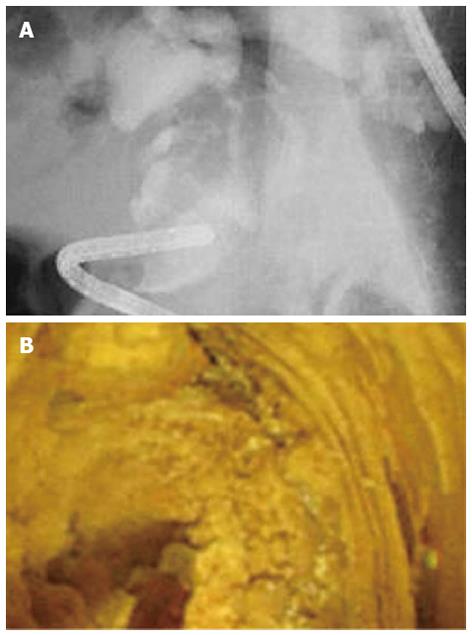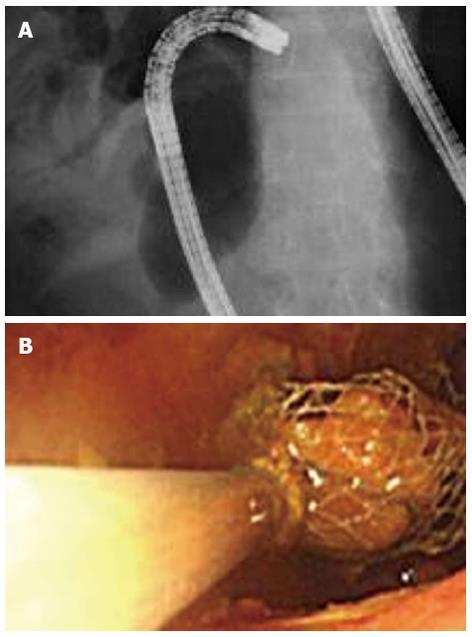Published online Mar 16, 2013. doi: 10.4253/wjge.v5.i3.132
Revised: September 6, 2012
Accepted: December 22, 2012
Published online: March 16, 2013
Recently, peroral direct cholangioscopy (PDCS) using an ultra-slim endoscope has come into the spotlight. However, the working channel is too small to use various devices for lithotripsy. We report a case of endoscopic lithotripsy with PDCS using a conventional endoscope as a cholangioscope. Computed tomography scan on an 80-year-old female who was admitted with acute cholangitis showed two large stones in the bile duct. Endoscopic retrograde cholangiopancreatography was attempted first. However, mechanical lithotripsy failed because the stone was too large for the basket catheter. Finally, electric hydraulic lithotripsy with PDCS using a conventional endoscope was performed allowed the stones to be cleared completely. In conclusion, PDCS using a conventional endoscope can be an alternative solution for endoscopic lithotripsy for patients with large stones in the dilated bile duct.
- Citation: Nakaji S, Hirata N, Shiratori T, Kobayashi M, Inase M. Endoscopic lithotripsy with peroral direct cholangioscopy using a conventional endoscope. World J Gastrointest Endosc 2013; 5(3): 132-134
- URL: https://www.wjgnet.com/1948-5190/full/v5/i3/132.htm
- DOI: https://dx.doi.org/10.4253/wjge.v5.i3.132
The peroral direct cholangioscopy (PDCS) procedure was first reported by Urakami et al[1] 3 decades ago. Recently, PDCS has come into the spotlight with the development of ultra-slim endoscopes. However, the working channel is too small to use various devices for lithotripsy. We report a case in endoscopic lithotripsy with PDCS using a conventional endoscope as the cholangioscope was used to avoid this problem. This is the first case of transpapillary lithotripsy using a conventional endoscope on a patient without a history of gastrectomy or gastro-jejunal anastomosis.
An 80-year-old female was admitted with acute cholangitis. Her past medical history included cholelithiasis and recurrent choledocholithiasis. Cholecystectomy had been performed at the age of 27. Choledocholithiasis had been treated endscopically and endoscopic sphincterotomy (EST) had been already performed. At the time of this admission, computed tomography (CT) scan showed two large stones in the bile duct. One was in the common bile duct (36.7 mm in diameter), while the other was in the left hepatic bile duct (21 mm in diameter). Endoscopic retrograde cholangiopancreatography was attempted first. However, mechanical lithotripsy failed because the stone was too large for the basket catheter. After we had obtained the patient’s consent, electric hydraulic lithotripsy (EHL) (Nortech AUTOLITH lithotripter with a 1.9F probe; Northgate Technologies, Illinois, United States) was performed with PDCS using an ultra-slim endoscope (GIF-XP260N; Olympus Medical Systems, Tokyo, Japan) (Figure 1). During the procedure, carbon dioxide was used to insufflate the bile duct. EHL was performed under saline solution irrigation. Although the stone was partially crushed, the view quickly deteriorated because of the presence of the fragments. Having had difficulty in lithotripsy with an ultra-slim endoscope, we changed to a conventional endoscope (GIF-Q260; Olympus Medical Systems) with a larger working channel (2.8 mm in diameter) to strengthen the suction power and to enable use of various devices. Both procedures were carried out under conscious sedation while monitoring the respiratory and circulatory dynamics with the patient in a prone position. Both endoscopes were inserted by the freehand method without balloon-assist or an overtube. After insertion, the crushing by EHL and suction were repeated. The fragments were removed using a retrieval net (Roth Net; Olympus Medical Systems) (Figure 2). In this way, stones were cleared completely. It took thirteen minutes to carry out the procedure.
At present, there are two types of scope used in peroral cholangioscopy: the single endoscope and the mother-baby type[2,3]. Both have advantages and disadvantages. For example, the mother-baby type is easier to insert into the bile duct, but is more difficult to handle. The Spy Glass System (Boston Scientific, Natick, MA, United States), a new mother-baby type cholangioscope that was developed recently, has improved insertability and handleability, but has drawbacks in actual lithotripsy, such as the small size of the working channel and the absence of an independent suction channel during lithotripsy.
The biggest problem of PDCS is the difficulty of insertion into the bile duct. The several techniques, such as the use of a sliding tube and a balloon catheter, were reported to facilitate insertion, but have not become well established. Moreover, a dedicated direct peroral cholangioscope has being developed recently[4]. PDCS using a conventional endoscope is usually more difficult to insert than an ultra-slim endoscope because of the diameter. However, endoscopic papillary large balloon dilation after EST may make insertion easier[5]. It also has the advantage of preventing increase in intra-biliary pressure during the procedure. Once a conventional endoscope has been inserted, various devices can be inserted through the 2.8 mm working channel: a mechanical lithotriptor (crusher catheter; Zeon Medical, Tokyo, Japan), a retrieval net, etc. Therefore, the lithotripsy can be easily completed in a short time. It is important to remember that this procedure should be performed under carbon dioxide insufflation to prevent air embolism[6]. There are no previous reports of transpapillary lithotripsy using a conventional endoscope, other than in patients the history of gastrectomy or gastro-jejunal anastomosis[7].
In conclusion, PDCS using a conventional endoscope can be an alternative solution for endoscopic lithotripsy in patients with large stones in the dilated bile duct. Although we have described one successful case further studies are needed to evaluate the safety and effectiveness of this procedure.
P- Reviewer Lucendo AJ S- Editor Song XX L- Editor Hughes D E- Editor Zhang DN
| 1. | Urakami Y, Seifert E, Butke H. Peroral direct cholangioscopy (PDCS) using routine straight-view endoscope: first report. Endoscopy. 1977;9:27-30. [PubMed] |
| 2. | Takekoshi T, Takagi K. Retrograde pancreatocholangioscopy. Gastroenterol Endosc. 1975;17:678-683. |
| 3. | Parsi MA. Peroral cholangioscopy in the new millennium. World J Gastroenterol. 2011;17:1-6. [RCA] [PubMed] [DOI] [Full Text] [Full Text (PDF)] [Cited by in CrossRef: 54] [Cited by in RCA: 44] [Article Influence: 3.1] [Reference Citation Analysis (0)] |
| 4. | Itoi T, Sofuni A, Itokawa F, Kurihara T, Tsuchiya T, Ishii K, Tsuji S, Gotoda T, Moon JH. Initial experience with a prototype peroral direct cholangioscope to perform intraductal lithotripsy (with video). Gastrointest Endosc. 2011;73:841-843. [PubMed] |
| 5. | Minami A, Hirose S, Nomoto T, Hayakawa S. Small sphincterotomy combined with papillary dilation with large balloon permits retrieval of large stones without mechanical lithotripsy. World J Gastroenterol. 2007;13:2179-2182. [PubMed] |
| 6. | Dellinger EP, Kirshenbaum G, Weinstein M, Steer M. Determinants of adverse reaction following postoperative T-tube cholangiogram. Ann Surg. 1980;191:397-403. [PubMed] |
| 7. | Prat F, Fritsch J, Choury AD, Frouge C, Marteau V, Etienne JP. Laser lithotripsy of difficult biliary stones. Gastrointest Endosc. 1994;40:290-295. [PubMed] |










